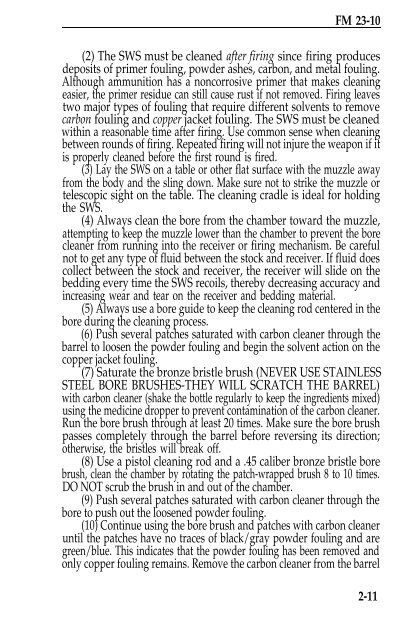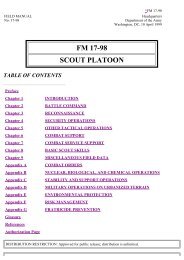- Page 1 and 2: *FM 23-10 17 August 1994 FIELD MANU
- Page 3 and 4: FM 23-10 iii
- Page 5 and 6: FM 23-10 v
- Page 7 and 8: FM 23-10 vii
- Page 9 and 10: FM 23-10 APPENDIX B M21 SNIPER WEAP
- Page 11 and 12: FM 23-10 B-3. CARE AND MAINTANCE Ex
- Page 13 and 14: FM 23-10 B-6. MALFUNCTIONS AND CORR
- Page 15 and 16: FM 23-10 B-7
- Page 17 and 18: FM 23-10 Section II M21 SIGHTING DE
- Page 19 and 20: FM 23-10 a. Magnification. The ART
- Page 21 and 22: FM 23-10 c. Design and Operation. T
- Page 23 and 24: FM 23-10 (6) Repeats the steps in p
- Page 25 and 26: FM 23-10 17 AUGUST 1994 By Order of
- Page 27 and 28: FM 23-10 extra supporting fire. The
- Page 29 and 30: FM 23-10 are reliability, initiativ
- Page 31 and 32: FM 23-10 1-5. TEAM FIRING TECHNIQUE
- Page 33 and 34: FM 23-10 2-2
- Page 35 and 36: FM 23-10 2-1. OPERATIONS AND FUNCTI
- Page 37 and 38: FM 23-10 (3) To lock the shoulder s
- Page 39 and 40: FM 23-10 weapon with his firing arm
- Page 41: FM 23-10 Carbon cleaner. Copper cle
- Page 45 and 46: FM 23-10 f. Cold Climates. In tempe
- Page 47 and 48: FM 23-10 f. Lift the stock assembly
- Page 49 and 50: FM 23-10 (9) Push in the magazine f
- Page 51 and 52: FM 23-10 2-20
- Page 53 and 54: FM 23-10 Section III SNIPER SIGHTIN
- Page 55 and 56: FM 23-10 WARNINGS 1. SECURELY FASTE
- Page 57 and 58: FM 23-10 (b) Keep the lens free fro
- Page 59 and 60: FM 23-10 e. Zeroing. Zeroing the M3
- Page 61 and 62: FM 23-10 (3) Remove one of the thre
- Page 63 and 64: FM 23-10 (1) Each click of adjustme
- Page 65 and 66: FM 23-10 nightsight’s limited ran
- Page 67 and 68: FM 23-10 2-36
- Page 69 and 70: FM 23-10 a. Components. Components
- Page 71 and 72: FM 23-10 2-16. M22 BINOCULARS The M
- Page 73 and 74: FM 23-10 2-19. AN/PRC-104A RADIO TR
- Page 75 and 76: FM 23-10 CHAPTER 3 MARKSMANSHIP Sni
- Page 77 and 78: FM 23-10 (7) Muscle relaxation. Whe
- Page 79 and 80: FM 23-10 (c) Keep the body in line
- Page 81 and 82: FM 23-10 (a) Place the left arm (no
- Page 83 and 84: FM 23-10 (b) To use vertical suppor
- Page 85 and 86: FM 23-10 d. Field-Expedient Weapon
- Page 87 and 88: FM 23-10 3-13
- Page 89 and 90: FM 23-10 (2) If the sniper is witho
- Page 91 and 92: FM 23-10 a. Eye Relief. This is the
- Page 93 and 94:
FM 23-10 e. Sight Picture. With tel
- Page 95 and 96:
FM 23-10 a. A respiratory cycle las
- Page 97 and 98:
FM 23-10 his shots. Proper follow-t
- Page 99 and 100:
FM 23-10 (4) Squeeze. As long as th
- Page 101 and 102:
FM 23-10 effect of change of the po
- Page 103 and 104:
FM 23-10 Section III EFFECTS OF WEA
- Page 105 and 106:
FM 23-10 3-13. WIND VELOCITY Before
- Page 107 and 108:
FM 23-10 e. As observed through the
- Page 109 and 110:
FM 23-10 3-35
- Page 111 and 112:
FM 23-10 can refer to this informat
- Page 113 and 114:
FM 23-10 of temperature, light, mir
- Page 115 and 116:
FM 23-10 target were to appear at 4
- Page 117 and 118:
FM 23-10 Section VI ENGAGEMENT OF M
- Page 119 and 120:
FM 23-10 fires the weapon when the
- Page 121 and 122:
FM 23-10 CHAPTER 4 FIELD TECHNIQUES
- Page 123 and 124:
FM 23-10 a. Natural. Natural camouf
- Page 125 and 126:
FM 23-10 b. The sniper team alters
- Page 127 and 128:
FM 23-10 (b) Shadows. The sniper te
- Page 129 and 130:
FM 23-10 4-9
- Page 131 and 132:
FM 23-10 4-9. SNIPER TEAM MOVEMENT
- Page 133 and 134:
FM 23-10 (2) Ambush. In an ambush,
- Page 135 and 136:
FM 23-10 b. A sniper team must reme
- Page 137 and 138:
FM 23-10 (2) Time: (a) Amount of ti
- Page 139 and 140:
FM 23-10 (b) Restricts observation
- Page 141 and 142:
FM 23-10 f. Semipermanent Hide. The
- Page 143 and 144:
FM 23-10 (b) lncreases risk of dete
- Page 145 and 146:
FM 23-10 4-25
- Page 147 and 148:
FM 23-10 (a) If the window is dirty
- Page 149 and 150:
FM 23-10 night vision sight, and ni
- Page 151 and 152:
FM 23-10 knowledge about what shoul
- Page 153 and 154:
FM 23-10 a. Purpose. The sniper tea
- Page 155 and 156:
FM 23-10 the enemy to a team’s pr
- Page 157 and 158:
FM 23-10 ensures it is long enough
- Page 159 and 160:
FM 23-10 (To convert inches to mete
- Page 161 and 162:
FM 23-10 This example may prove to
- Page 163 and 164:
FM 23-10 4-27. MILITARY SKETCH DA F
- Page 165 and 166:
FM 23-10 (5) Grid coordinates. (6)
- Page 167 and 168:
d. Grid coordinates of the sniper t
- Page 169 and 170:
FM 23-10 estimate; when time is ava
- Page 171 and 172:
FM 23-10 d. Coordination with Forwa
- Page 173 and 174:
FM 23-10 Flight route planned (star
- Page 175 and 176:
FM 23-10 5-7. BRIEFBACK The sniper
- Page 177 and 178:
FM 23-10 and that the observer know
- Page 179 and 180:
FM 23-10 (7) Discovery of single ex
- Page 181 and 182:
FM 23-10 45 rounds 9-mm ball ammuni
- Page 183 and 184:
FM 23-10 Extra large ALICE pack, co
- Page 185 and 186:
FM 23-10 Glass cutter. Masonry dril
- Page 187 and 188:
FM 23-10 multiple routes and means
- Page 189 and 190:
FM 23-10 abort the mission. In the
- Page 191 and 192:
FM 23-10 (3) Drop Site. The drop si
- Page 193 and 194:
FM 23-10 so when the enemy has tota
- Page 195 and 196:
FM 23-10 prevent infiltration of th
- Page 197 and 198:
FM 23-10 k. Ensures it has a natura
- Page 199 and 200:
FM 23-10 individual abilities, trai
- Page 201 and 202:
FM 23-10 CHAPTER 7 COMMUNICATIONS T
- Page 203 and 204:
FM 23-10 . (2) If the antenna is da
- Page 205 and 206:
FM 23-10 a. End-Fed Half-Wave Anten
- Page 207 and 208:
FM 23-10 (1) Compute the length of
- Page 209 and 210:
FM 23-10 7-4. FIELD-EXPEDIENT DIREC
- Page 211 and 212:
FM 23-10 7-11
- Page 213 and 214:
FM 23-10 7-6. ANTENNA ORIENTATION I
- Page 215 and 216:
FM 23-10 battery, the load on the b
- Page 217 and 218:
FM 23-10 plane must be tuned to the
- Page 219 and 220:
FM 23-10 the other is held down by
- Page 221 and 222:
FM 23-10 power amplifiers and radio
- Page 223 and 224:
FM 23-10 explosion will have degrad
- Page 225 and 226:
FM 23-10 LINE 6 Personnel strength.
- Page 227 and 228:
FM 23-10 f. Dimensions. (1) From: (
- Page 229 and 230:
FM 23-10 ITEM 3 - 1 (encypted) or R
- Page 231 and 232:
FM 23-10 7-19. ENEMY PRISONER OF WA
- Page 233 and 234:
FM 23-10 LINE 18 OR PAPA ALPHA- Gri
- Page 235 and 236:
FM 23-10 CHAPTER 8 TRACKING/COUNTER
- Page 237 and 238:
FM 23-10 8-3
- Page 239 and 240:
FM 23-10 (4) If the person being fo
- Page 241 and 242:
FM 23-10 c. A light rain may round
- Page 243 and 244:
FM 23-10 the area. Therefore, a sni
- Page 245 and 246:
FM 23-10 handler’s last position
- Page 247 and 248:
FM 23-10 8-13
- Page 249 and 250:
FM 23-10 the stream. The sniper tea
- Page 251 and 252:
FM 23-10 CHAPTER 9 SNIPER SUSTAINME
- Page 253 and 254:
FM 23-10 The only exception to this
- Page 255 and 256:
FM 23-10 d. Concealed Movement. Con
- Page 257 and 258:
FM 23-10 e. Target Detection. Targe
- Page 259 and 260:
FM 23-10 f. Range Estimation. Snipe
- Page 261 and 262:
FM 23-10 9-11
- Page 263 and 264:
FM 23-10 while observing and record
- Page 265 and 266:
Encoding/decoding. Encrypting/decry
- Page 267 and 268:
FM 23-10 9-17
- Page 269 and 270:
FM 23-10 9-19
- Page 271 and 272:
FM 23-10 b. Insertion/Extraction Te
- Page 273 and 274:
FM 23-10 (4) Moving targets can be
- Page 275 and 276:
FM 23-10 9-4. EXAMPLE 5-DAY SNIPER
- Page 277 and 278:
FM 23-10 TASK 7: Prepare a sniper r
- Page 279 and 280:
FM 23-10 CONDITIONS: Given a review
- Page 281 and 282:
FM 23-10 DAY 4 TASK 1: Quality on Q
- Page 283 and 284:
FM 23-10 STANDARDS: Transmit the fi
- Page 285 and 286:
FM 23-10 TIME ACTION 1200 Sniper te
- Page 287 and 288:
FM 23-10 Fire a first-round hit to
- Page 289 and 290:
FM 23-10 9-39
- Page 291:
FM 23-10 weapon undisturbed by outs
- Page 304 and 305:
FM 23-10 bull's-eye target . any ta
- Page 306 and 307:
FM 23-10 hrs . . . . . . . .. hours
- Page 308 and 309:
FM 23-10 PD . . . . . . . . . point
- Page 310 and 311:
FM 23-10 steady position . . the fi
- Page 312 and 313:
FM 23-10 Index-1
- Page 314 and 315:
FM 23-10 Index-3
- Page 316 and 317:
FM 23-10 Index-5
- Page 318 and 319:
FM 23-10 REFERENCES SOURCES USED Th
- Page 320 and 321:
FM 23-10 FM 34-3. Intelligence Anal
- Page 322 and 323:
FM 23-10 A-2. BELGIUM The Model 30-
- Page 324 and 325:
FM 23-10 A-7. ISRAEL The Israelis c
- Page 326 and 327:
FM 23-10 this weapon is 0.75 MOA at











